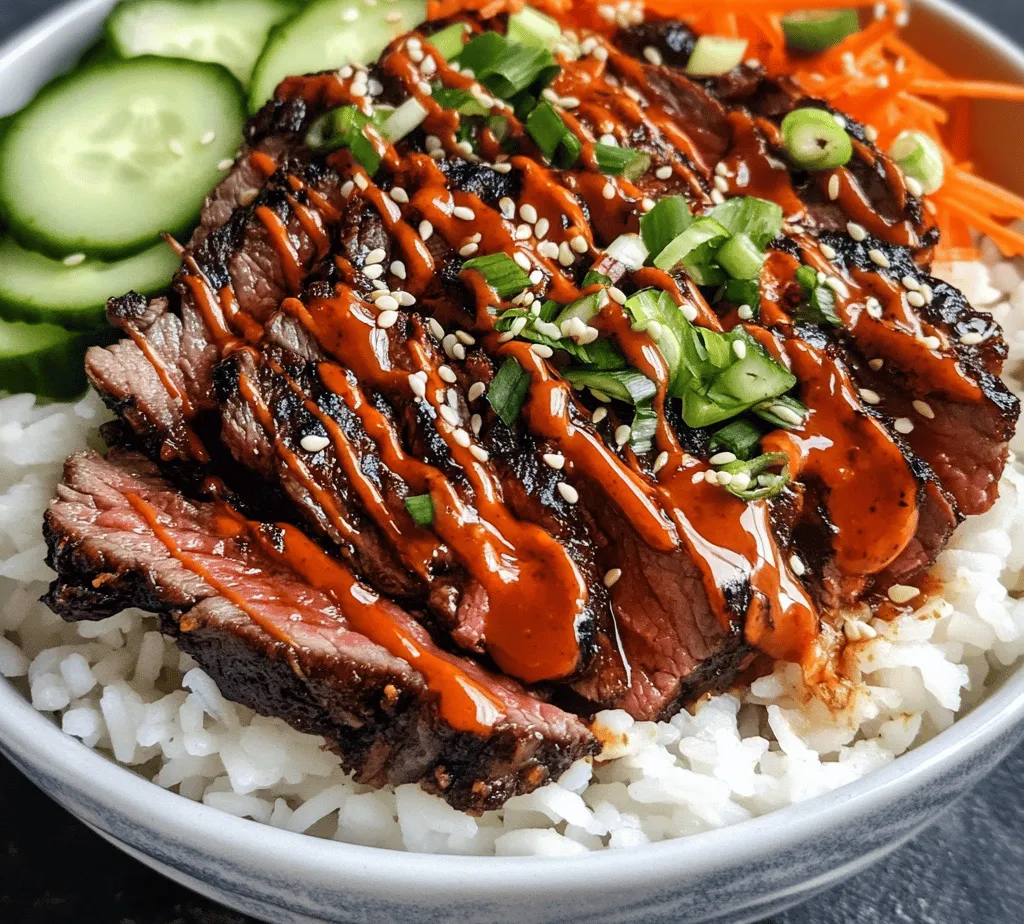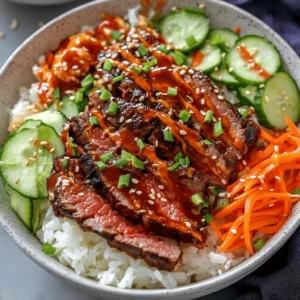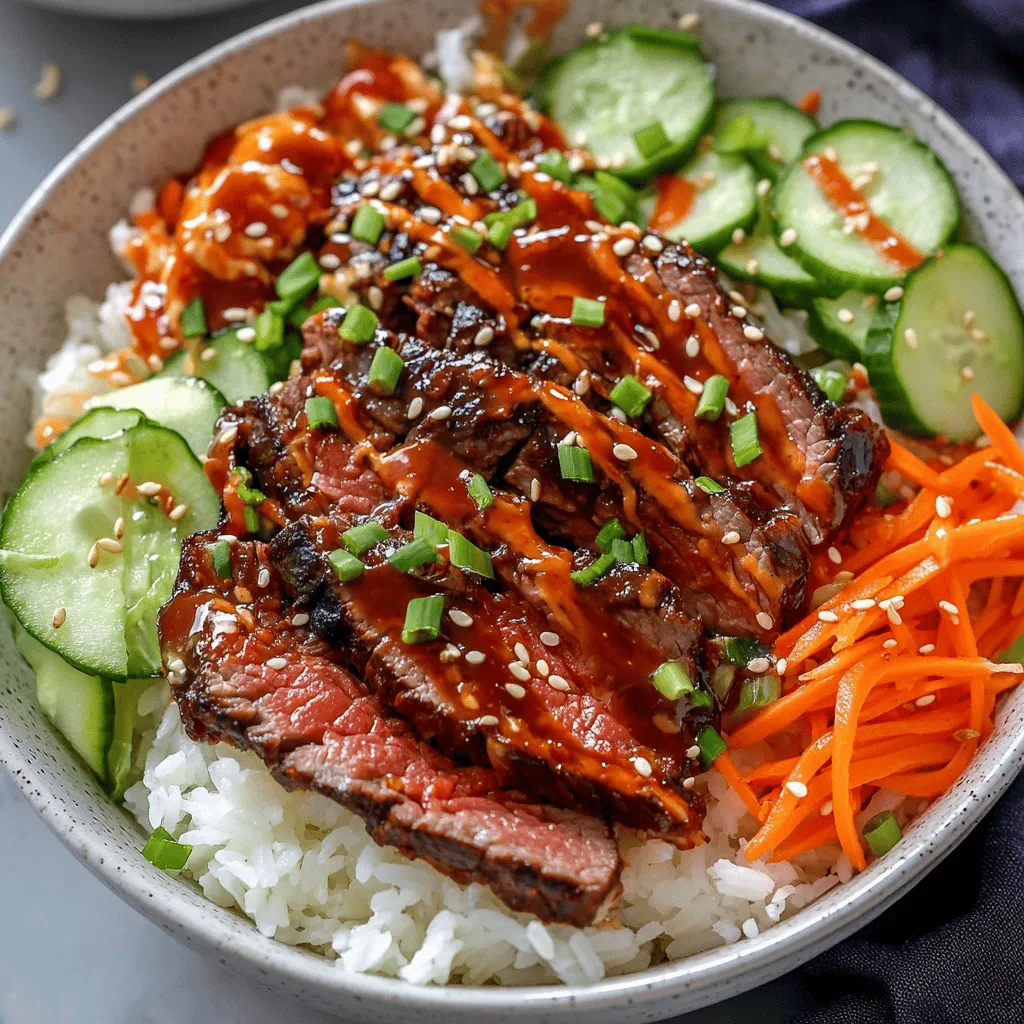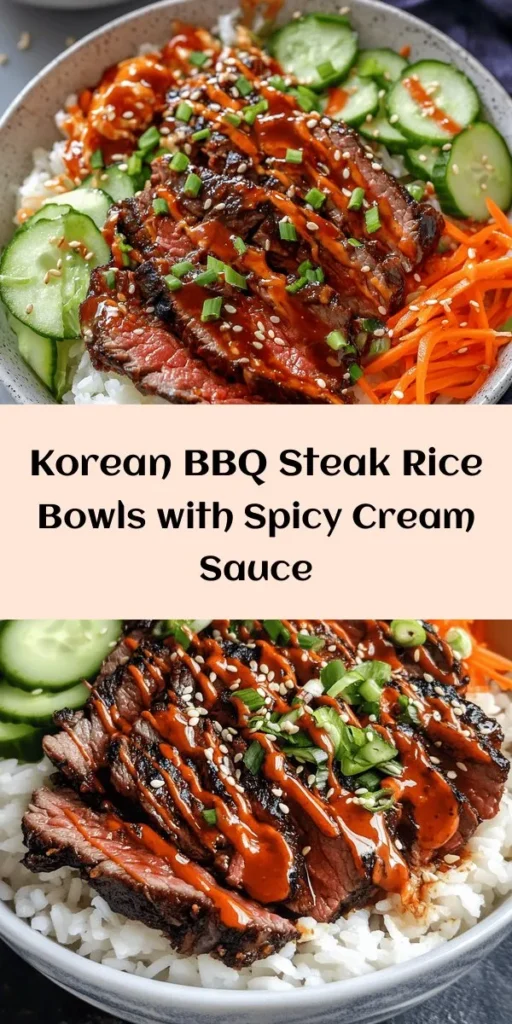Introduction
Korean BBQ has taken the culinary world by storm, captivating food lovers with its unique blend of flavors and interactive dining experience. Originating from Korea, this beloved cuisine combines marinated meats cooked over a grill with an array of side dishes, creating a vibrant feast that appeals to all senses. Among the various offerings of Korean BBQ, the Korean BBQ Steak Rice Bowls with Spicy Cream Sauce stands out as a deliciously convenient option, perfectly merging traditional elements with modern dining needs.
This dish encapsulates the essence of Korean BBQ, featuring tender steak marinated in a savory blend of spices, served over a bed of fluffy jasmine rice, and topped with a spicy cream sauce that adds a delightful kick. The fusion of flavors—from the umami-rich marinade to the creaminess of the sauce—creates a satisfying meal that is not only delicious but also visually appealing. For busy individuals and families looking for a quick yet fulfilling dinner option, these rice bowls are a perfect solution, allowing you to enjoy the tastes of Korean BBQ from the comfort of your home.
Understanding Korean BBQ
To truly appreciate the Korean BBQ Steak Rice Bowls, it is essential to understand the culture and culinary practices behind Korean BBQ. In Korea, BBQ is much more than a meal; it is a social event where friends and family gather around a grill, preparing and sharing food together. The experience is often accompanied by a variety of banchan (side dishes), which can include pickled vegetables, kimchi, and more, enhancing the overall dining experience.
At the heart of Korean BBQ is the marination of meats, particularly beef. Common cuts used include short ribs, ribeye, and flank steak, all of which benefit greatly from marination. The marinade typically consists of ingredients like soy sauce, sesame oil, garlic, and ginger, which not only impart flavor but also help tenderize the meat. This step is crucial, as it allows the steak to absorb the rich flavors before being grilled to perfection.
The cooking methods used in Korean BBQ can vary. Traditional grilling takes place over charcoal, infusing the meat with a smoky essence, while modern adaptations may employ gas grills or stovetop grills. Regardless of the method, the goal remains the same: to create juicy, flavorful steak that is the star of the dish.
Ingredient Breakdown
Creating the Korean BBQ Steak Rice Bowls requires a selection of key ingredients that come together to deliver a harmonious blend of taste and texture. Let’s explore the essential components of this recipe.
Flank Steak
The choice of meat plays a pivotal role in this dish, and flank steak is an excellent option for Korean BBQ. Known for its robust flavor and slightly chewy texture, flank steak benefits significantly from marination. This cut is lean yet flavorful, making it a favorite for grilling. When cooked correctly, flank steak can be incredibly tender, especially when sliced against the grain. Additionally, it is a cost-effective choice for families looking to enjoy a delicious meal without breaking the bank.
Marinade Components
The marinade is the heart of the flavor profile in Korean BBQ Steak Rice Bowls. Here are the key ingredients that contribute to the marinade:
– Soy Sauce: A staple in Korean cuisine, soy sauce provides a salty umami flavor that enhances the meat’s natural taste.
– Brown Sugar: This ingredient adds a touch of sweetness, balancing the saltiness of the soy sauce and helping to achieve a caramelized crust when grilled.
– Sesame Oil: With its nutty aroma, sesame oil adds depth to the marinade and complements the other ingredients.
– Garlic and Ginger: Fresh garlic and ginger infuse the steak with aromatic flavors, essential to achieving authentic Korean BBQ taste.
– Black Pepper: A simple yet effective way to add a hint of heat and complexity to the marinade.
Rice Bowl Elements
A base of perfectly cooked jasmine rice elevates the dish, providing a neutral canvas for the flavorful steak and sauce. Jasmine rice is known for its fragrant aroma and delicate texture, making it an ideal pairing. Additionally, fresh vegetables add crunch and color to the rice bowl. Common elements include:
– Shredded Carrots: Adding a touch of sweetness and vibrant color.
– Cucumber: Crisp and refreshing, cucumber balances the richness of the steak.
– Napa Cabbage: This tender cabbage adds a subtle crunch and is often used in various Korean dishes.
Spicy Cream Sauce
To elevate the bowls further, a spicy cream sauce brings an exciting dimension to the dish. Here’s what you’ll need for the sauce:
– Mayonnaise: The base of the sauce, providing creaminess that complements the steak and rice.
– Gochujang: A staple in Korean cooking, this fermented chili paste adds a rich, spicy flavor that defines the dish.
– Rice Vinegar: A splash of rice vinegar cuts through the richness of the mayonnaise, adding tanginess and brightness.
– Lime Juice: Fresh lime juice adds acidity, balancing the flavors and enhancing the overall profile of the sauce.
– Honey: A touch of honey rounds out the sauce, providing sweetness that complements the heat from the gochujang.
Step-by-Step Guide to Making Korean BBQ Steak Rice Bowls
Marinating the Steak
Marination is a critical step that should not be overlooked. It enhances the flavor of the steak and ensures tenderness. Here’s how to marinate the flank steak:
1. Prepare the Marinade: In a mixing bowl, combine soy sauce, brown sugar, sesame oil, minced garlic, grated ginger, and freshly ground black pepper. Whisk until the sugar is dissolved and the ingredients are well incorporated.
2. Marinate the Steak: Place the flank steak in a shallow dish or a resealable plastic bag. Pour the marinade over the steak, ensuring it is fully coated. Seal the bag or cover the dish, and refrigerate. Ideally, marinate the steak for at least 30 minutes, but for the best results, allow it to marinate for 2-4 hours. This extra time will allow the flavors to penetrate deeper into the meat.
3. Remove and Rest: Once marinated, take the steak out of the refrigerator and let it rest at room temperature for about 15-20 minutes before cooking. This helps it cook more evenly.
Cooking the Rice
While the steak is marinating, you can prepare the jasmine rice. Here’s how to achieve perfectly fluffy rice:
1. Rinse the Rice: Start by rinsing 1 cup of jasmine rice under cold water until the water runs clear. This step removes excess starch and prevents the rice from becoming sticky.
2. Cook the Rice: In a medium saucepan, combine the rinsed rice with 1 ¾ cups of water. Add a pinch of salt for flavor. Bring the water to a boil over medium-high heat. Once boiling, reduce the heat to low, cover, and let it simmer for about 15 minutes. Avoid lifting the lid during cooking, as this can disrupt the steam needed to cook the rice properly.
3. Fluff and Rest: After 15 minutes, remove the saucepan from heat and let it sit, covered, for an additional 5 minutes. Fluff the rice with a fork before serving. For added flavor, you can stir in a small drizzle of sesame oil or a sprinkle of chopped scallions.
4. Variations: For those looking to add an extra layer of flavor, consider cooking the rice in chicken or vegetable broth instead of water. You can also add a few whole garlic cloves or a bay leaf to the pot for an aromatic touch.
With the steak marinated and the rice prepared, you are well on your way to assembling the delicious Korean BBQ Steak Rice Bowls. The next steps will involve cooking the steak to perfection and assembling the bowls with fresh vegetables and the spicy cream sauce for that final touch of flavor. Stay tuned for the complete guide!

Preparing the Vegetables
In creating a delicious Korean BBQ Steak Rice Bowl, the choice and preparation of vegetables play a crucial role in elevating the dish’s flavor and visual appeal. Fresh vegetables not only add color and crunch but also provide essential nutrients that enhance the overall meal.
Options for Raw Versus Cooked Vegetables
You can opt for both raw and cooked vegetables to create a harmonious contrast in texture. Common choices for raw vegetables include cucumber, shredded carrots, and radishes. These options provide a refreshing crunch and balance the richness of the steak and sauce. On the other hand, lightly sautéed vegetables such as bell peppers, zucchini, and snap peas contribute warmth and tenderness while still maintaining a slight crispness.
If you prefer cooked vegetables, blanching them briefly in boiling water before shocking them in ice water preserves their vibrant colors and nutrients. This method ensures that the vegetables retain a slight crunch while being fully cooked, adding more depth to your dish.
Nutritional Benefits of the Chosen Vegetables
The vegetables you choose not only enhance the flavor but also bring numerous health benefits. For instance:
– Cucumbers: Hydrating and low in calories, cucumbers are a great source of vitamin K and antioxidants. They add a refreshing crunch to your rice bowl.
– Carrots: Rich in beta-carotene and vitamins A and C, carrots improve vision and boost immune health. Their natural sweetness complements savory elements in the dish.
– Bell Peppers: High in vitamin C and antioxidants, bell peppers add a colorful pop to your bowl while promoting heart health.
– Zucchini: Low in calories and high in fiber, zucchini aids digestion and keeps you feeling full.
Incorporating a variety of vegetables not only enhances the dish aesthetically but also ensures a well-rounded nutritional profile, making your Korean BBQ Steak Rice Bowl both delicious and healthy.
Creating the Spicy Cream Sauce
The spicy cream sauce is the heart of the Korean BBQ Steak Rice Bowl, offering a creamy yet zesty flavor that ties all the components together. Crafting the perfect sauce involves balancing flavors and adjusting spice levels to suit your palate.
Balancing Flavors in the Sauce
To create the ideal spicy cream sauce, start with a base of mayonnaise or Greek yogurt for creaminess. Add gochujang (Korean chili paste) for heat and depth. A splash of rice vinegar introduces acidity, which balances the richness of the sauce. Season with soy sauce for umami and a hint of garlic for added flavor.
When mixing, taste as you go. The goal is to achieve a sauce that is creamy, spicy, tangy, and savory all at once. If you find it too thick, thin it out with a bit of water or additional vinegar. Conversely, if the sauce is too spicy, you can balance it with more mayonnaise or yogurt.
Adjusting Spice Levels for Different Taste Preferences
Spice levels can be easily adjusted to cater to different preferences. For those who enjoy a milder taste, start with a smaller amount of gochujang and gradually increase it until the desired heat is reached. Alternatively, if you prefer a more intense flavor, you can add a sprinkle of red pepper flakes or a dash of sriracha for an extra kick.
Remember, the key is to create a sauce that complements the steak without overpowering the other flavors in the bowl.
Cooking the Steak
Cooking the steak to perfection is essential in achieving a flavorful Korean BBQ Steak Rice Bowl. The right technique can make all the difference in texture and taste.
Techniques for Achieving the Desired Doneness
To cook the steak, first, ensure it is at room temperature by letting it sit out for about 30 minutes before cooking. This helps to ensure even cooking. Season the steak generously with salt and pepper, and if desired, a sprinkle of garlic powder or sesame oil for added flavor.
You can grill, pan-sear, or broil the steak based on your preference. For a grill, preheat to medium-high heat, and cook for about 4-5 minutes per side for medium-rare, or until it reaches your preferred doneness. For pan-searing, use a cast-iron skillet over medium-high heat and add a bit of oil. Sear each side for 3-4 minutes, depending on thickness.
Importance of Resting the Steak Before Slicing
After cooking, let the steak rest for at least 5-10 minutes before slicing. This resting period allows the juices to redistribute throughout the meat, resulting in a juicier and more flavorful steak. When ready, slice the steak against the grain into thin strips for maximum tenderness.
Assembling the Bowls
Once all the components are prepared, it’s time to assemble your Korean BBQ Steak Rice Bowls. A visually appealing presentation not only enhances the dining experience but also makes the dish more appetizing.
Visual Appeal of the Final Dish
Start with a generous scoop of rice as the base. Arrange the sliced steak on one side, and then add your choice of vegetables on the other. For an inviting look, consider using color contrast; for example, vibrant red bell peppers, bright green cucumbers, and orange carrots create an appealing palette.
Drizzle the spicy cream sauce over the steak or serve it on the side for dipping. Garnish with sesame seeds, sliced green onions, or a sprinkle of nori for an extra touch of flavor and visual interest.
Suggestions for Layering Ingredients for Optimal Flavor
For optimal flavor, layer the ingredients thoughtfully. Start with the rice, then add the steak, followed by the vegetables. This layering allows the sauce to cascade down, coating everything below. Serve with lime wedges for a refreshing hit of acidity that enhances the overall flavor profile.
Flavor Profiles and Pairing Suggestions
The flavor profile of Korean BBQ Steak Rice Bowls is a delightful interplay of savory, spicy, and umami elements. Each bite combines the rich, smoky flavor of the grilled steak with the refreshing crunch of vegetables and the unique heat of the spicy cream sauce.
Discussion on the Umami and Spicy Elements of the Dish
Umami is a key characteristic of this dish, primarily derived from the beef and complementary ingredients like soy sauce and gochujang. The spiciness from the sauce adds an exciting kick that elevates the meal without overwhelming the palate. Together, these elements create a satisfying and well-rounded flavor experience.
Suggested Pairings
To enhance your meal, consider pairing your Korean BBQ Steak Rice Bowls with a fresh cucumber salad or kimchi for an extra burst of flavor. As for beverages, cold beers like a Korean lager or a refreshing iced tea work wonderfully to balance the spiciness. For a non-alcoholic option, try a tangy lemonade or a sparkling water with a slice of lemon.
Exploring Variations
Feel free to explore variations of this dish by substituting proteins or altering spice levels. Chicken, pork, or even tofu can serve as excellent alternatives to beef, catering to different dietary preferences. Additionally, you can experiment with different sauces, such as a sweet soy glaze or a tangy sesame dressing, to create a unique twist on the classic bowl.
Nutritional Information
Understanding the nutritional content of your meal is crucial, especially for those monitoring their intake. A typical serving of Korean BBQ Steak Rice Bowls (including rice, steak, vegetables, and spicy cream sauce) provides approximately:
– Calories: 600-700 calories
– Protein: 30-35 grams
– Carbohydrates: 70-80 grams
– Fats: 20-25 grams
Health Benefits of the Ingredients Used
The combination of lean protein from the steak, fiber from the vegetables, and complex carbohydrates from the rice makes this dish a balanced meal option. The use of fresh ingredients enhances the dish’s nutritional value, providing vitamins and minerals essential for overall health.
Caloric Considerations
For those watching their caloric intake, consider reducing the amount of rice or sauce used or opting for a lighter protein option. You could also incorporate more vegetables to increase the volume of the dish without significantly increasing calories.
Conclusion
Korean BBQ Steak Rice Bowls offer a delicious and convenient way to enjoy the rich flavors of Korean cuisine in the comfort of your home. With a medley of flavors and textures, this dish is not only satisfying but also adaptable to various dietary needs.
Encouraging experimentation with ingredients, spice levels, and presentation can make this dish a versatile staple in your culinary repertoire. Whether you’re serving it at a family dinner or enjoying it on a busy weeknight, these rice bowls promise a flavorful experience that showcases the essence of Korean cooking. So grab your ingredients, fire up the grill, and indulge in a delightful meal that’s sure to impress!



